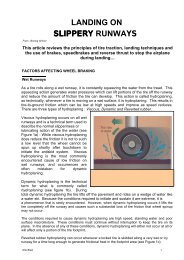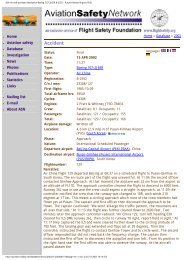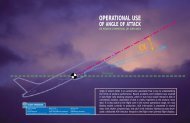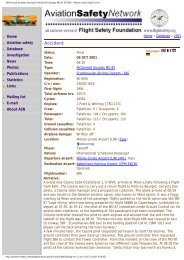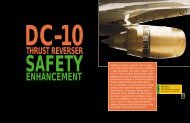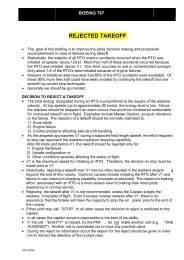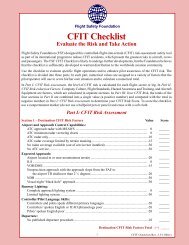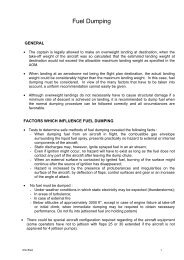Boeing 737-236 series 1, G-BGJL: Main document - Leonardo
Boeing 737-236 series 1, G-BGJL: Main document - Leonardo
Boeing 737-236 series 1, G-BGJL: Main document - Leonardo
Create successful ePaper yourself
Turn your PDF publications into a flip-book with our unique Google optimized e-Paper software.
1.6.2 Engines<br />
1.6.2.1 General<br />
The Pratt and Whitney JT8D-15 is a two-shaft turbofan engine.The combustion section is canannular<br />
and comprises 9 combustorcans enclosed by a Combustion Chamber Outer Case (CCOC)<br />
(Appendix5 Fig b). Compressor delivery air enters the CCOC, where a smallproportion is mixed<br />
with fuel in the combustor cans and ignitedto produce the combustion flame. The remainder of the<br />
compressorair flows around the inner and outer walls of the cans to providea cooling flow (note:<br />
the combustion temperatures are above themelting point of the can materials and thus the cooling<br />
flow isessential to maintain can integrity). Whilst the combustor canscontain the combustion<br />
process, the CCOC must withstand the compressordelivery pressure (in the order of 240 psi at takeoff<br />
conditions)and it is therefore essentially a pressure vessel. It is basicallya one-piece tube of<br />
AMS 5603 steel alloy with flanges fore andaft which attach to the engine casing by two rings of<br />
steel bolts.<br />
The combustor cans themselves comprise a cast Stellite dome, orhead, and 11 liners of Hastelloy X<br />
sheet material (Appendix 5Fig c). The dome incorporates swirl vanes which direct the<br />
incomingcompressor delivery airflow into the can prior to mixing withfuel from the fuel nozzle<br />
which is inserted into the centre ofthe dome. The fuel nozzle also provides radial location of<br />
theforward end of the can. Axial location is achieved via an integrallug on the dome which picks up<br />
on a mounting pin bolted to thediffuser case. The remainder of the can is constructed from 11rings<br />
(liners) of sheet Hastelloy X material of varying diametersto achieve the desired profile of the can.<br />
Liner 3 incorporatesthe flame transfer ports to adjacent cans. The liners are resistanceseam-welded<br />
to each other. The aft end of liner 11 is a slidingfit in the transition duct bulkhead, which provides<br />
radial supportfor the rear of the can but allows movement in an axial directionto accommodate<br />
thermal expansion and contraction. Can numbers4 and 7 also have an igniter plug boss incorporated<br />
in Liner 2.All cans are fitted with an "air scoop" over the topof liner 2, as part of a programme to<br />
reduce the engine's smokeemission.<br />
Cooling of the liners is achieved by directing the relativelycool compressor delivery air over the<br />
outside surfaces of thecan and onto the inner surface through small film-cooling holesadjacent to<br />
each liner joint. Since there is a pressure differentialof about +3% of compressor delivery pressure<br />
from outside to insideof the can, cooling air will flow inwards. Larger holes in theliner also allow<br />
larger volumes of air to flow in locally to cooland adjust the combustion gas flow pattern inside the<br />
can.<br />
The combustor cans fitted to G-<strong>BGJL</strong>'s engines were to Pratt andWhitney modification standard<br />
5192, ie. the latest standard applicableto the JT8D-15 at the time of the accident. The modification<br />
wasintended to overcome various problems encountered on the previousstandard of can, including<br />
cracking of the seam weld between linernumbers 2 and 3. This was felt to be particularly<br />
undesirablebecause it occurred under the air scoop and could only be detectedby radiographic<br />
techniques. It was stated by the manufacturerthat this modification standard would provide a<br />
combustor canof "improved durability".<br />
The combustion section is further enclosed by an aluminium alloyfan case which forms the by-pass<br />
duct and is the externally visiblepart of the engine casing in this area.<br />
Each engine was fitted with a thrust reverser system typical ofreverser systems fitted to this<br />
category of aircraft, comprisinga pair of clam-shell doors which swung on linkages from<br />
theirstowed position (around the exhaust duct) into a position aftof the engine, where they deflected<br />
the exhaust gases sidewaysand slightly forwards to provide reverse thrust (Appendix 6 Figa).



